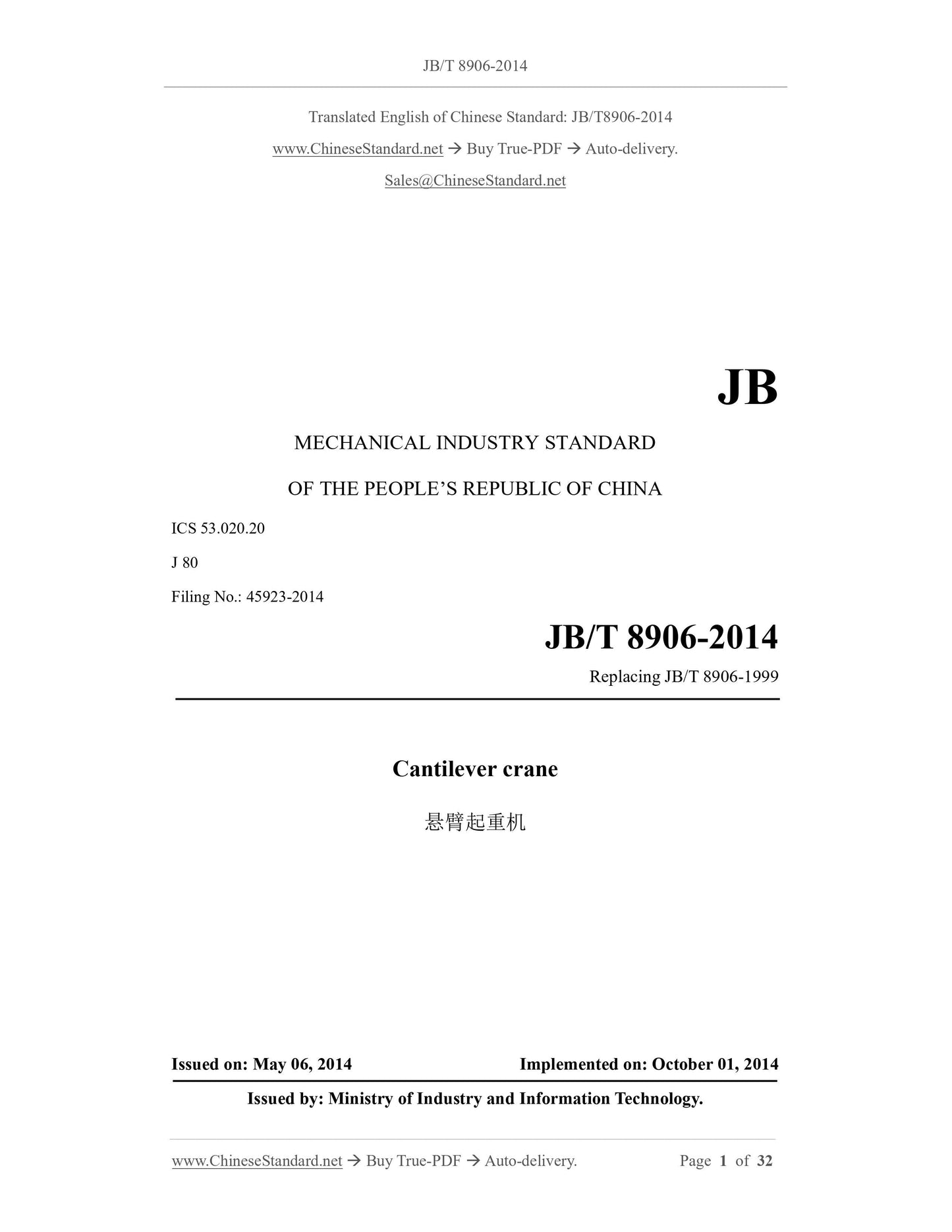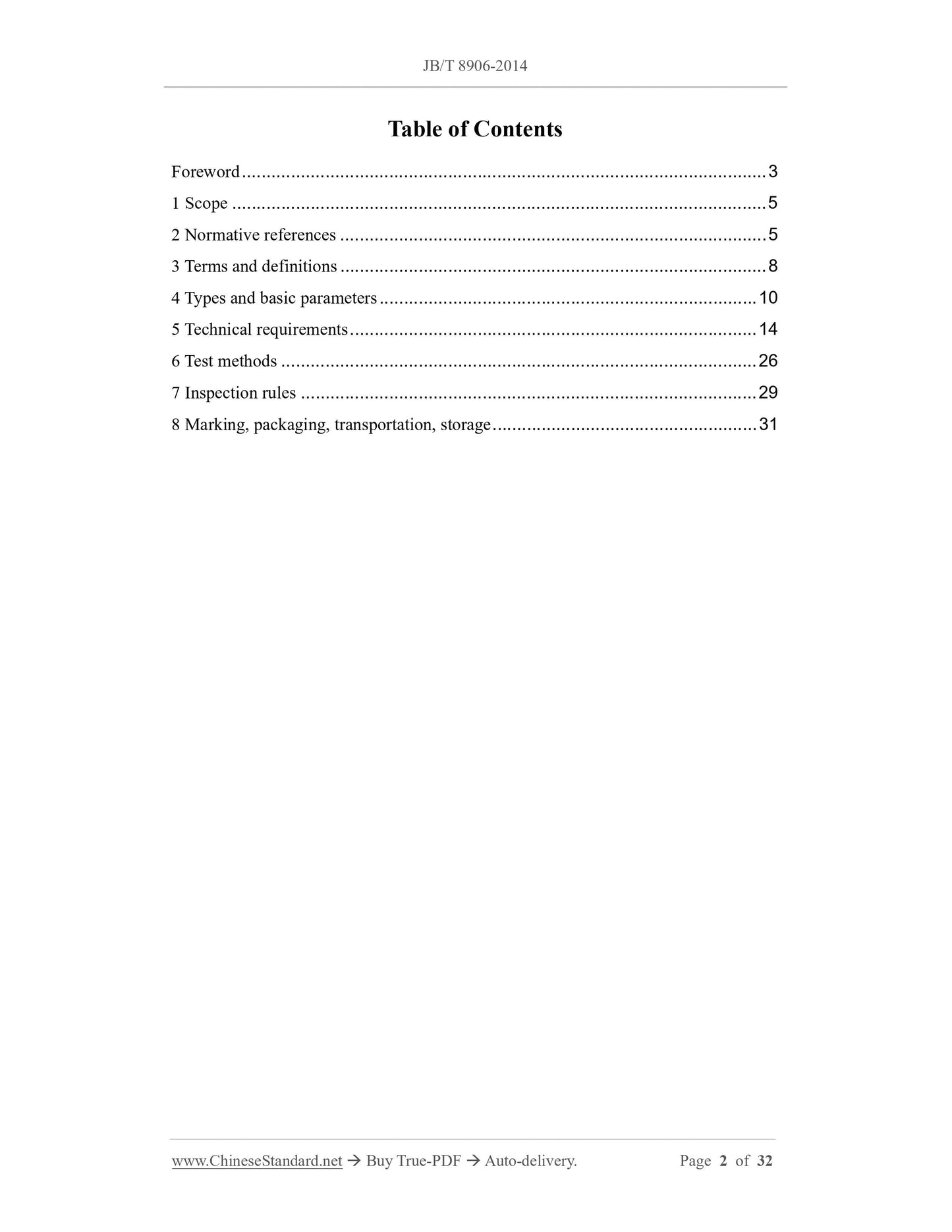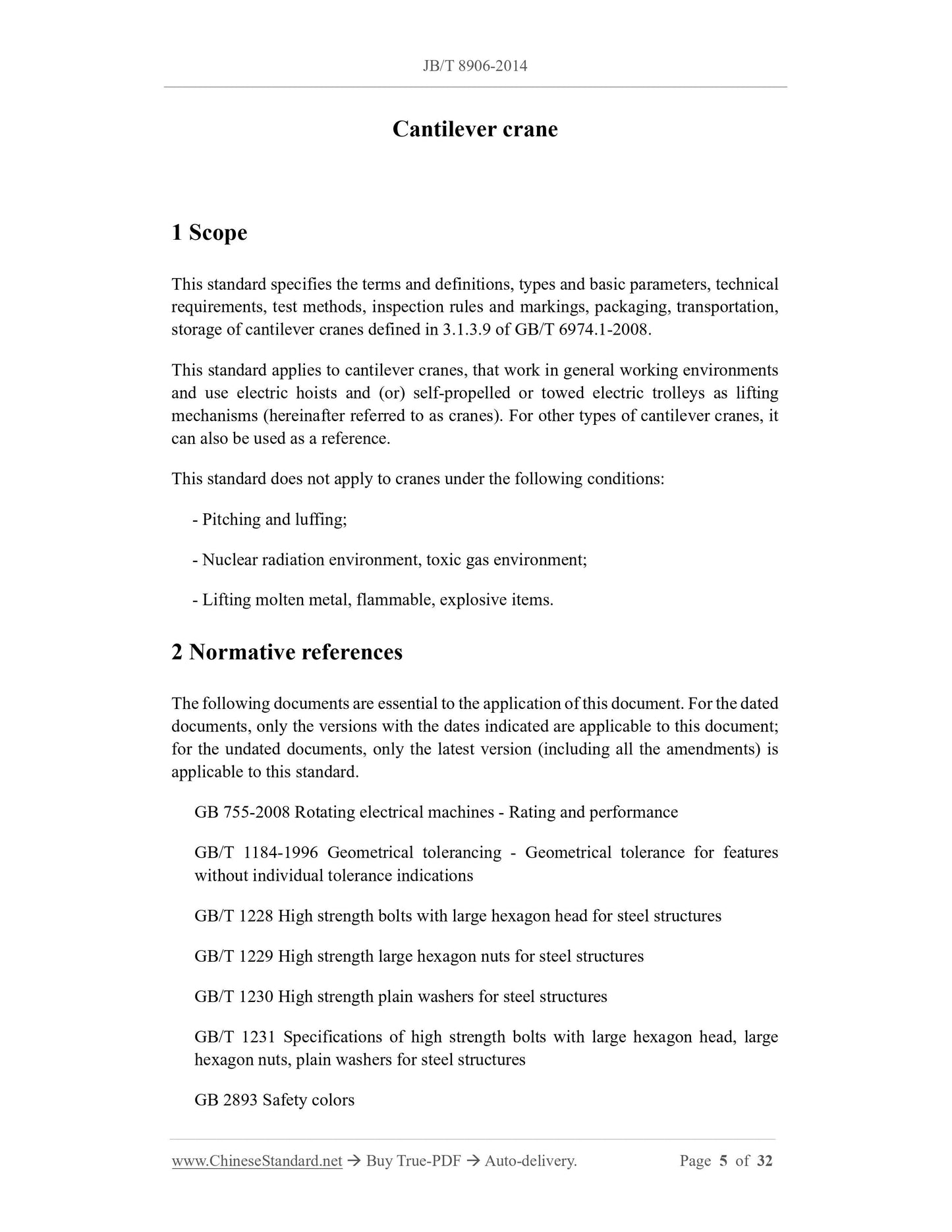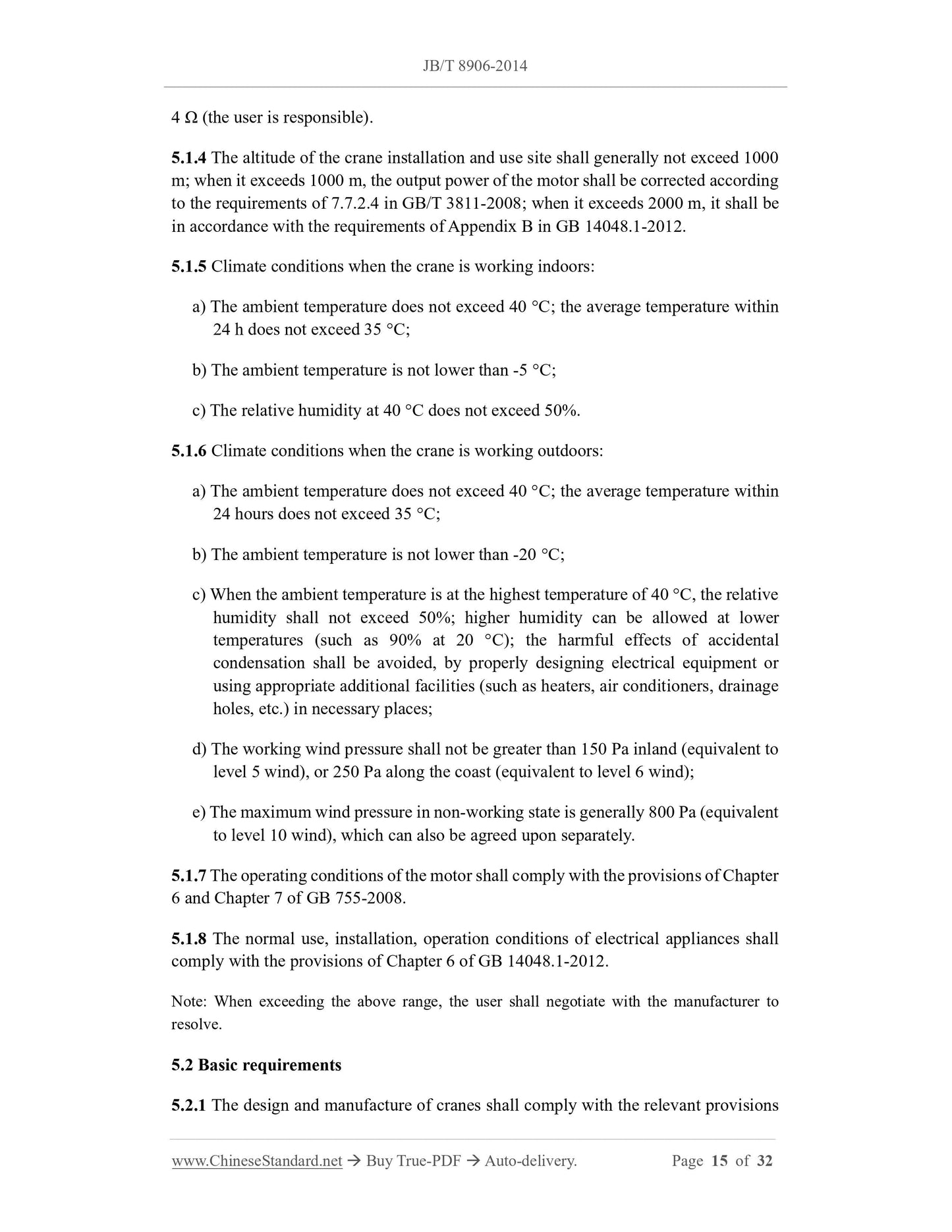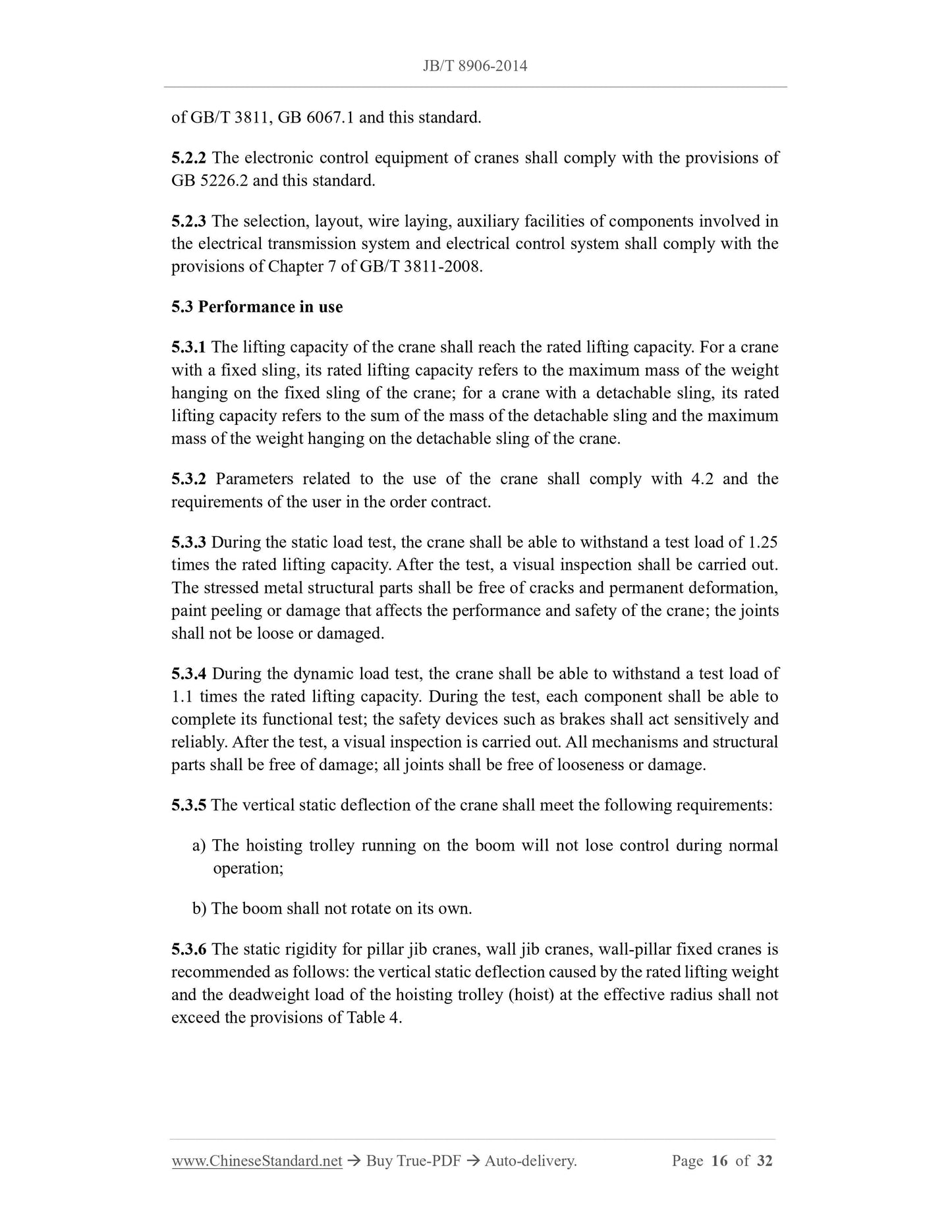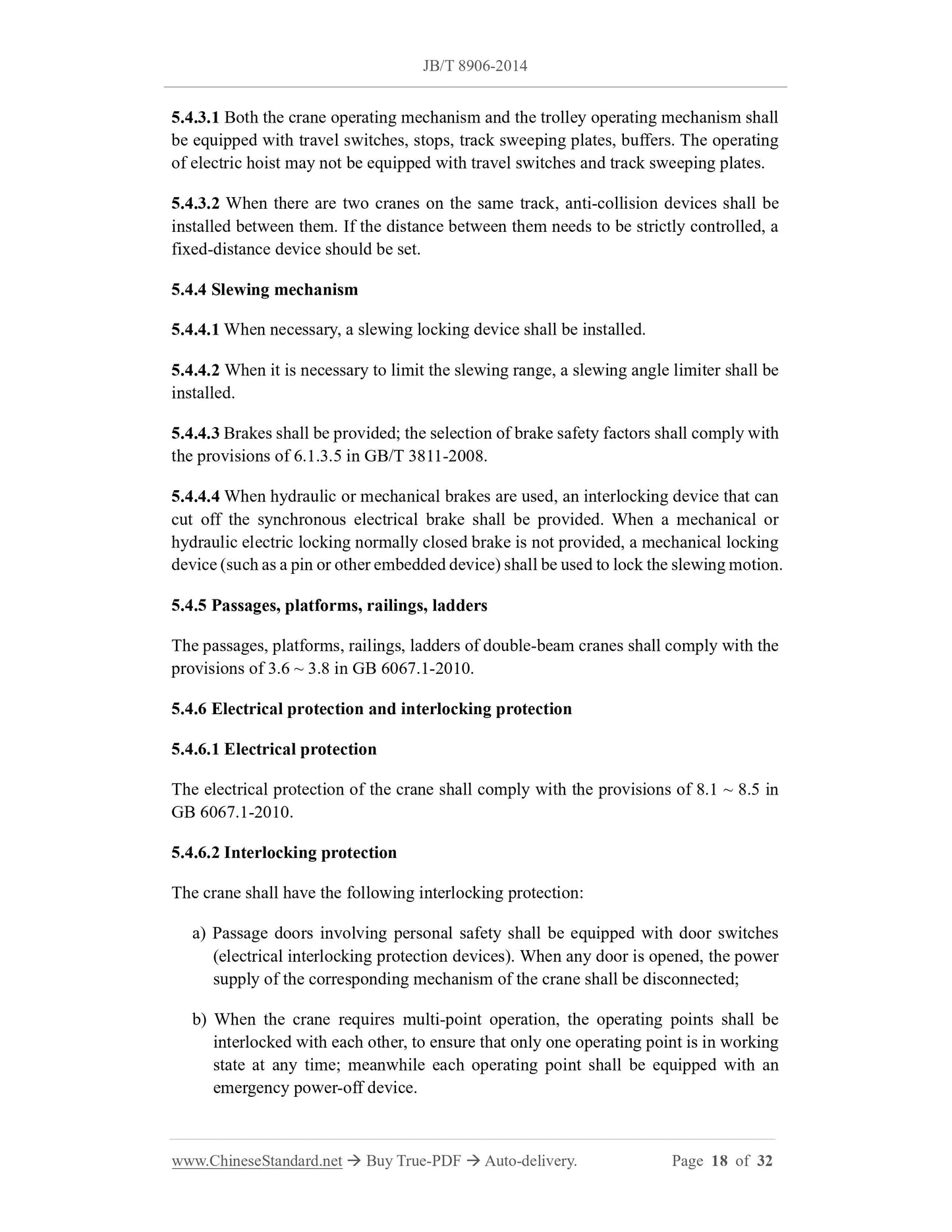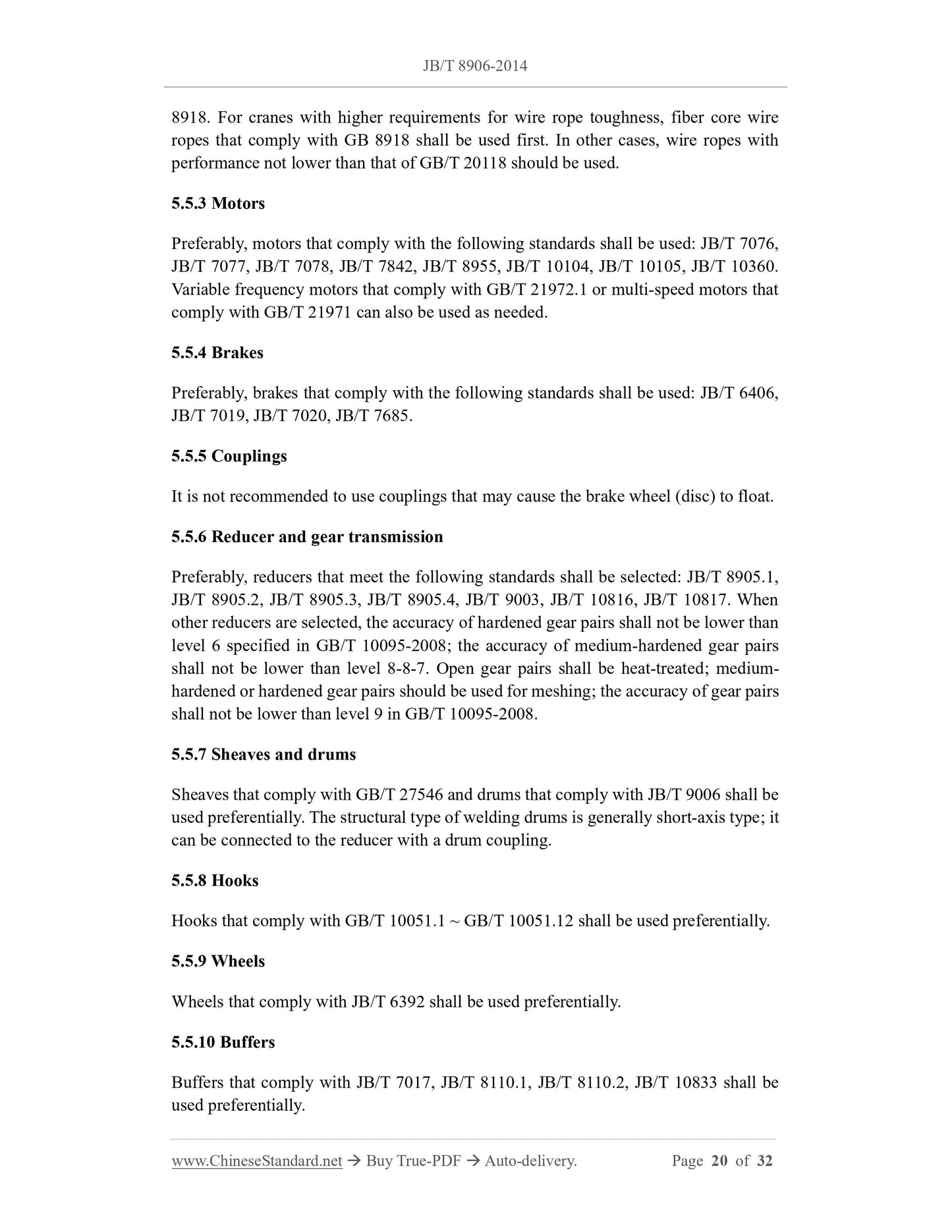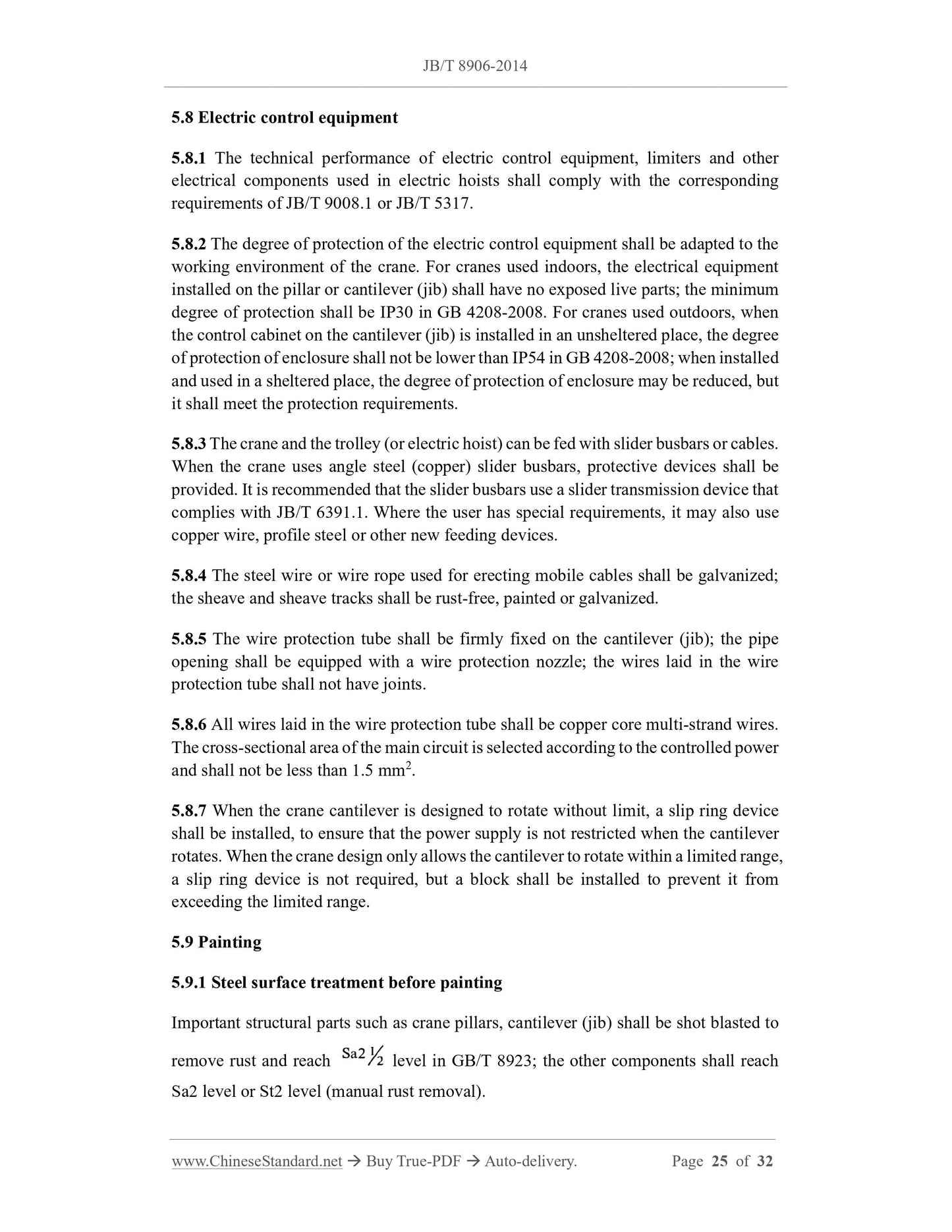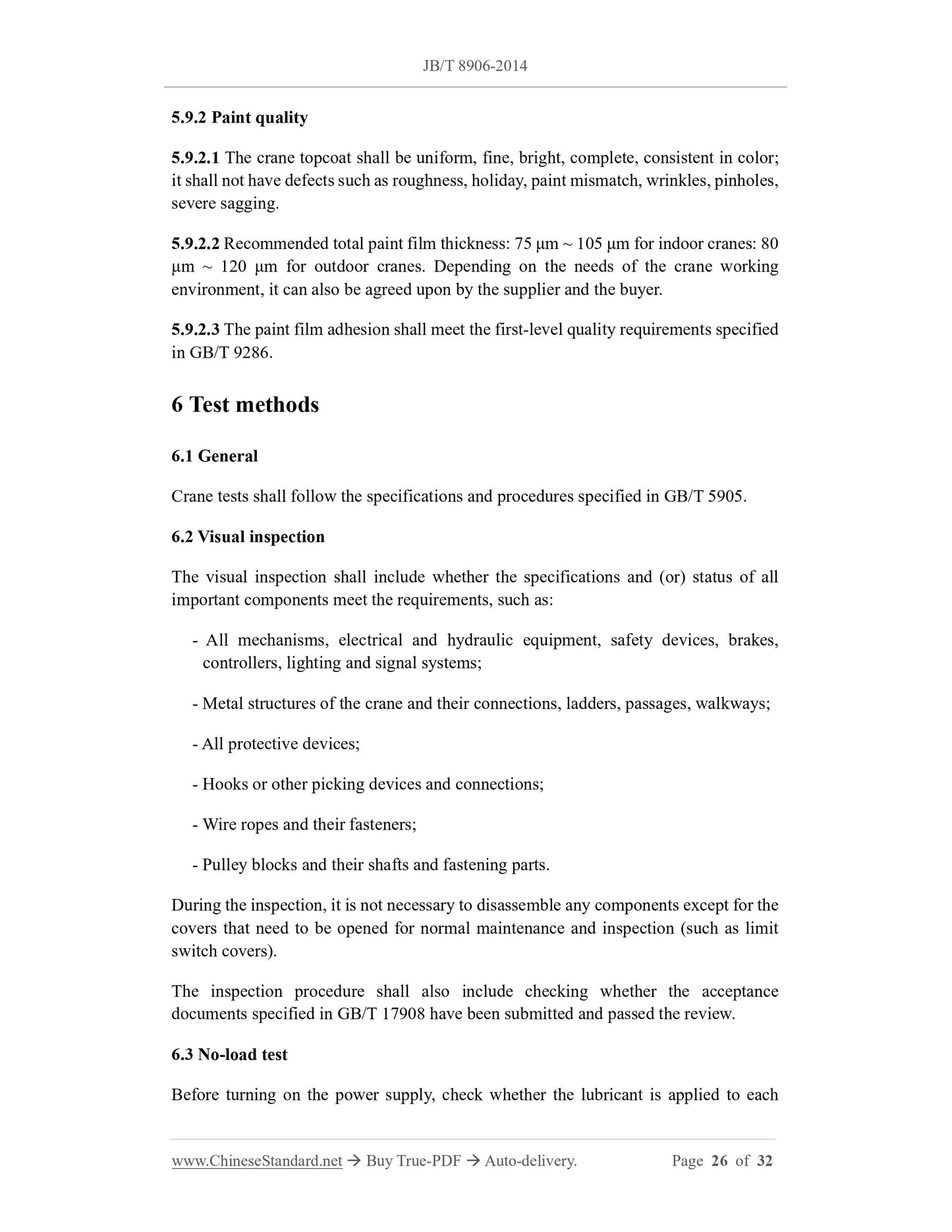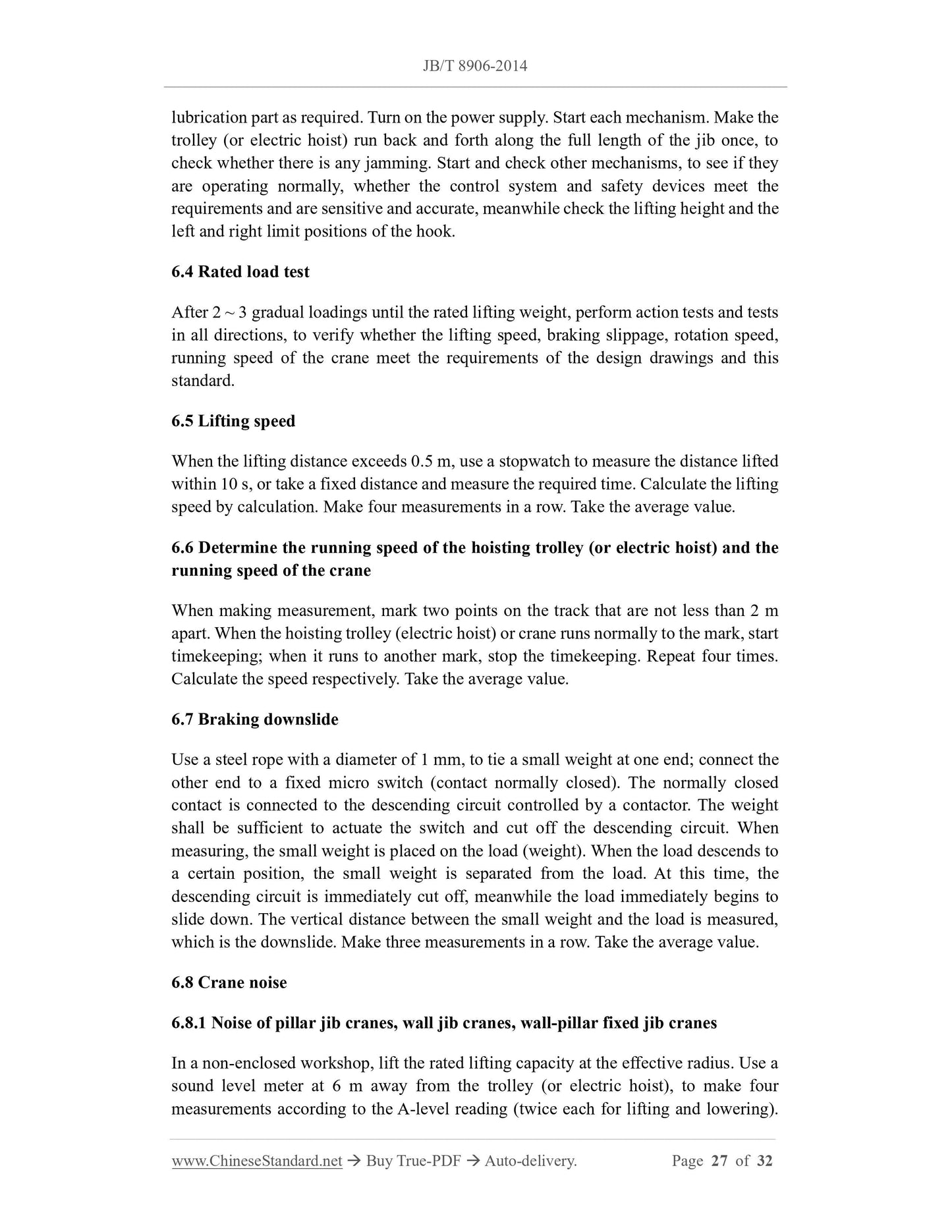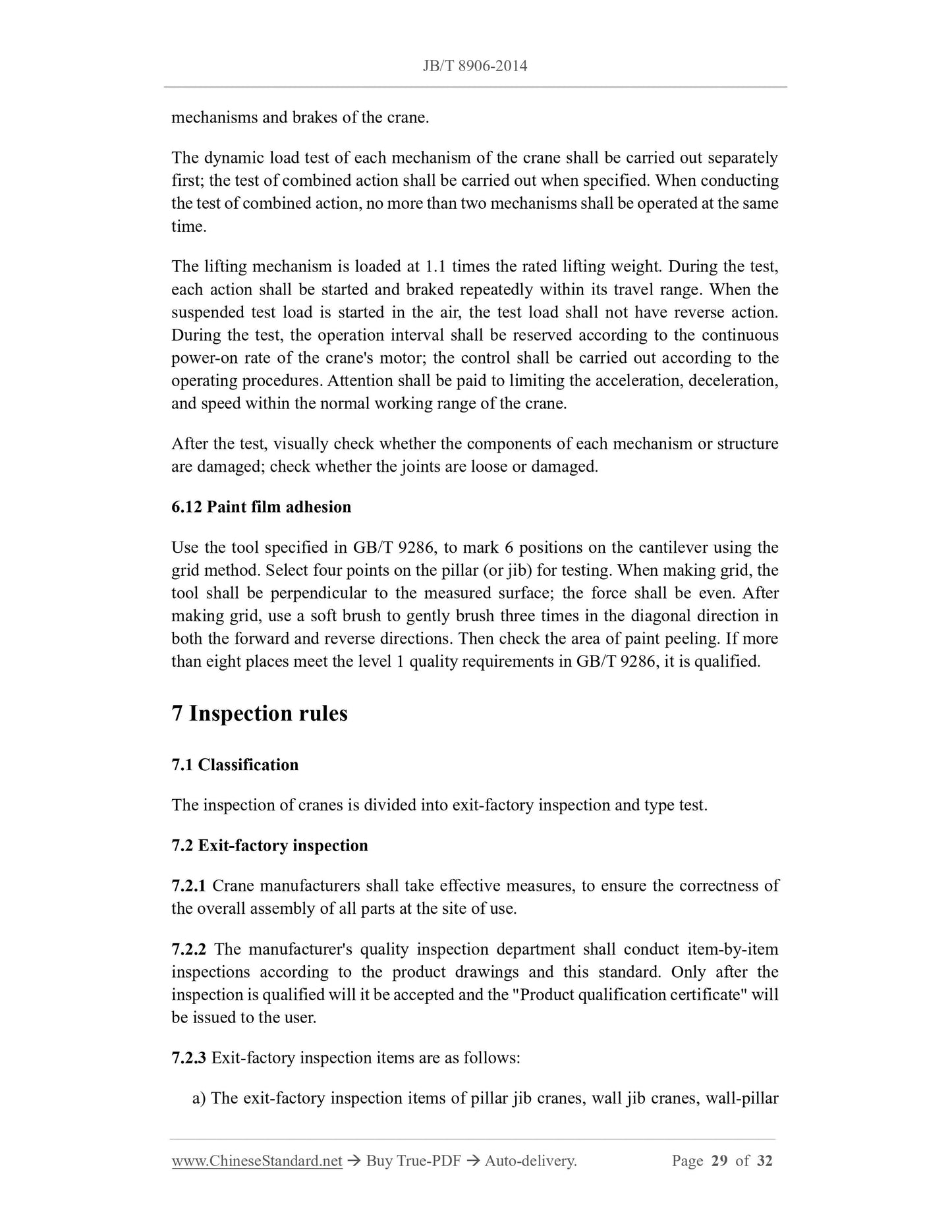1
/
of
12
PayPal, credit cards. Download editable-PDF and invoice in 1 second!
JB/T 8906-2014 English PDF (JB/T8906-2014)
JB/T 8906-2014 English PDF (JB/T8906-2014)
Regular price
$405.00 USD
Regular price
Sale price
$405.00 USD
Unit price
/
per
Shipping calculated at checkout.
Couldn't load pickup availability
Delivery: 3 seconds. Download true-PDF + Invoice.
Get QUOTATION in 1-minute: Click JB/T 8906-2014
Historical versions: JB/T 8906-2014
Preview True-PDF (Reload/Scroll if blank)
JB/T 8906-2014: Cantilever crane
JB/T 8906-2014
JB
MECHANICAL INDUSTRY STANDARD
OF THE PEOPLE’S REPUBLIC OF CHINA
ICS 53.020.20
J 80
Filing No.: 45923-2014
Replacing JB/T 8906-1999
Cantilever crane
ISSUED ON: MAY 06, 2014
IMPLEMENTED ON: OCTOBER 01, 2014
Issued by: Ministry of Industry and Information Technology.
Table of Contents
Foreword ... 3
1 Scope ... 5
2 Normative references ... 5
3 Terms and definitions ... 8
4 Types and basic parameters ... 10
5 Technical requirements ... 14
6 Test methods ... 26
7 Inspection rules ... 29
8 Marking, packaging, transportation, storage ... 31
Cantilever crane
1 Scope
This standard specifies the terms and definitions, types and basic parameters, technical
requirements, test methods, inspection rules and markings, packaging, transportation,
storage of cantilever cranes defined in 3.1.3.9 of GB/T 6974.1-2008.
This standard applies to cantilever cranes, that work in general working environments
and use electric hoists and (or) self-propelled or towed electric trolleys as lifting
mechanisms (hereinafter referred to as cranes). For other types of cantilever cranes, it
can also be used as a reference.
This standard does not apply to cranes under the following conditions:
- Pitching and luffing;
- Nuclear radiation environment, toxic gas environment;
- Lifting molten metal, flammable, explosive items.
2 Normative references
The following documents are essential to the application of this document. For the dated
documents, only the versions with the dates indicated are applicable to this document;
for the undated documents, only the latest version (including all the amendments) is
applicable to this standard.
GB 755-2008 Rotating electrical machines - Rating and performance
GB/T 1184-1996 Geometrical tolerancing - Geometrical tolerance for features
without individual tolerance indications
GB/T 1228 High strength bolts with large hexagon head for steel structures
GB/T 1229 High strength large hexagon nuts for steel structures
GB/T 1230 High strength plain washers for steel structures
GB/T 1231 Specifications of high strength bolts with large hexagon head, large
hexagon nuts, plain washers for steel structures
GB 2893 Safety colors
4 Ω (the user is responsible).
5.1.4 The altitude of the crane installation and use site shall generally not exceed 1000
m; when it exceeds 1000 m, the output power of the motor shall be corrected according
to the requirements of 7.7.2.4 in GB/T 3811-2008; when it exceeds 2000 m, it shall be
in accordance with the requirements of Appendix B in GB 14048.1-2012.
5.1.5 Climate conditions when the crane is working indoors:
a) The ambient temperature does not exceed 40 °C; the average temperature within
24 h does not exceed 35 °C;
b) The ambient temperature is not lower than -5 °C;
c) The relative humidity at 40 °C does not exceed 50%.
5.1.6 Climate conditions when the crane is working outdoors:
a) The ambient temperature does not exceed 40 °C; the average temperature within
24 hours does not exceed 35 °C;
b) The ambient temperature is not lower than -20 °C;
c) When the ambient temperature is at the highest temperature of 40 °C, the relative
humidity shall not exceed 50%; higher humidity can be allowed at lower
temperatures (such as 90% at 20 °C); the harmful effects of accidental
condensation shall be avoided, by properly designing electrical equipment or
using appropriate additional facilities (such as heaters, air conditioners, drainage
holes, etc.) in necessary places;
d) The working wind pressure shall not be greater than 150 Pa inland (equivalent to
level 5 wind), or 250 Pa along the coast (equivalent to level 6 wind);
e) The maximum wind pressure in non-working state is generally 800 Pa (equivalent
to level 10 wind), which can also be agreed upon separately.
5.1.7 The operating conditions of the motor shall comply with the provisions of Chapter
6 and Chapter 7 of GB 755-2008.
5.1.8 The normal use, installation, operation conditions of electrical appliances shall
comply with the provisions of Chapter 6 of GB 14048.1-2012.
Note: When exceeding the above range, the user shall negotiate with the manufacturer to
resolve.
5.2 Basic requirements
5.2.1 The design and manufacture of cranes shall comply with the relevant provisions
of GB/T 3811, GB 6067.1 and this standard.
5.2.2 The electronic control equipment of cranes shall comply with the provisions of
GB 5226.2 and this standard.
5.2.3 The selection, layout, wire laying, auxiliary facilities of components involved in
the electrical transmission system and electrical control system shall comply with the
provisions of Chapter 7 of GB/T 3811-2008.
5.3 Performance in use
5.3.1 The lifting capacity of the crane shall reach the rated lifting capacity. For a crane
with a fixed sling, its rated lifting capacity refers to the maximum mass of the weight
hanging on the fixed sling of the crane; for a crane with a detachable sling, its rated
lifting capacity refers to the sum of the mass of the detachable sling and the maximum
mass of the weight hanging on the detachable sling of the crane.
5.3.2 Parameters related to the use of the crane shall comply with 4.2 and the
requirements of the user in the order contract.
5.3.3 During the static load test, the crane shall be able to withstand a test load of 1.25
times the rated lifting capacity. After the test, a visual inspection shall be carried out.
The stressed metal structural parts shall be free of cracks and permanent deformation,
paint peeling or damage that affects the performance and safety of the crane; the joints
shall not be loose or damaged.
5.3.4 During the dynamic load test, the crane shall be able to withstand a test load of
1.1 times the rated lifting capacity. During the test, each component shall be able to
complete its functional test; the safety devices such as brakes shall act sensitively and
reliably. After the test, a visual inspection is carried out. All mechanisms and structural
parts shall be free of damage; all joints shall be free of looseness or damage.
5.3.5 The vertical static deflection of the crane shall meet the following requirements:
a) The hoisting trolley running on the boom will not lose control during normal
operation;
b) The boom shall not rotate on its own.
5.3.6 The static rigidity for pillar jib cranes, wall jib cranes, wall-pillar fixed cranes is
recommended as follows: the vertical static deflection caused by the rated lifting weight
and the deadweight load of the hoisting trolley (hoist) at the effective radius shall not
exceed the provisions of Table 4.
5.4.3.1 Both the crane operating mechanism and the trolley operating mechanism shall
be equipped with travel switches, stops, track sweeping plates, buffers. The operating
of electric hoist may not be equipped with travel switches and track sweeping plates.
5.4.3.2 When there are two cranes on the same track, anti-collision devices shall be
installed between them. If the distance between them needs to be strictly controlled, a
fixed-distance device should be set.
5.4.4 Slewing mechanism
5.4.4.1 When necessary, a slewing locking device shall be installed.
5.4.4.2 When it is necessary to limit the slewing range, a slewing angle limiter shall be
installed.
5.4.4.3 Brakes shall be provided; the selection of brake safety factors shall comply with
the provisions of 6.1.3.5 in GB/T 3811-2008.
5.4.4.4 When hydraulic or mechanical brakes are ...
Get QUOTATION in 1-minute: Click JB/T 8906-2014
Historical versions: JB/T 8906-2014
Preview True-PDF (Reload/Scroll if blank)
JB/T 8906-2014: Cantilever crane
JB/T 8906-2014
JB
MECHANICAL INDUSTRY STANDARD
OF THE PEOPLE’S REPUBLIC OF CHINA
ICS 53.020.20
J 80
Filing No.: 45923-2014
Replacing JB/T 8906-1999
Cantilever crane
ISSUED ON: MAY 06, 2014
IMPLEMENTED ON: OCTOBER 01, 2014
Issued by: Ministry of Industry and Information Technology.
Table of Contents
Foreword ... 3
1 Scope ... 5
2 Normative references ... 5
3 Terms and definitions ... 8
4 Types and basic parameters ... 10
5 Technical requirements ... 14
6 Test methods ... 26
7 Inspection rules ... 29
8 Marking, packaging, transportation, storage ... 31
Cantilever crane
1 Scope
This standard specifies the terms and definitions, types and basic parameters, technical
requirements, test methods, inspection rules and markings, packaging, transportation,
storage of cantilever cranes defined in 3.1.3.9 of GB/T 6974.1-2008.
This standard applies to cantilever cranes, that work in general working environments
and use electric hoists and (or) self-propelled or towed electric trolleys as lifting
mechanisms (hereinafter referred to as cranes). For other types of cantilever cranes, it
can also be used as a reference.
This standard does not apply to cranes under the following conditions:
- Pitching and luffing;
- Nuclear radiation environment, toxic gas environment;
- Lifting molten metal, flammable, explosive items.
2 Normative references
The following documents are essential to the application of this document. For the dated
documents, only the versions with the dates indicated are applicable to this document;
for the undated documents, only the latest version (including all the amendments) is
applicable to this standard.
GB 755-2008 Rotating electrical machines - Rating and performance
GB/T 1184-1996 Geometrical tolerancing - Geometrical tolerance for features
without individual tolerance indications
GB/T 1228 High strength bolts with large hexagon head for steel structures
GB/T 1229 High strength large hexagon nuts for steel structures
GB/T 1230 High strength plain washers for steel structures
GB/T 1231 Specifications of high strength bolts with large hexagon head, large
hexagon nuts, plain washers for steel structures
GB 2893 Safety colors
4 Ω (the user is responsible).
5.1.4 The altitude of the crane installation and use site shall generally not exceed 1000
m; when it exceeds 1000 m, the output power of the motor shall be corrected according
to the requirements of 7.7.2.4 in GB/T 3811-2008; when it exceeds 2000 m, it shall be
in accordance with the requirements of Appendix B in GB 14048.1-2012.
5.1.5 Climate conditions when the crane is working indoors:
a) The ambient temperature does not exceed 40 °C; the average temperature within
24 h does not exceed 35 °C;
b) The ambient temperature is not lower than -5 °C;
c) The relative humidity at 40 °C does not exceed 50%.
5.1.6 Climate conditions when the crane is working outdoors:
a) The ambient temperature does not exceed 40 °C; the average temperature within
24 hours does not exceed 35 °C;
b) The ambient temperature is not lower than -20 °C;
c) When the ambient temperature is at the highest temperature of 40 °C, the relative
humidity shall not exceed 50%; higher humidity can be allowed at lower
temperatures (such as 90% at 20 °C); the harmful effects of accidental
condensation shall be avoided, by properly designing electrical equipment or
using appropriate additional facilities (such as heaters, air conditioners, drainage
holes, etc.) in necessary places;
d) The working wind pressure shall not be greater than 150 Pa inland (equivalent to
level 5 wind), or 250 Pa along the coast (equivalent to level 6 wind);
e) The maximum wind pressure in non-working state is generally 800 Pa (equivalent
to level 10 wind), which can also be agreed upon separately.
5.1.7 The operating conditions of the motor shall comply with the provisions of Chapter
6 and Chapter 7 of GB 755-2008.
5.1.8 The normal use, installation, operation conditions of electrical appliances shall
comply with the provisions of Chapter 6 of GB 14048.1-2012.
Note: When exceeding the above range, the user shall negotiate with the manufacturer to
resolve.
5.2 Basic requirements
5.2.1 The design and manufacture of cranes shall comply with the relevant provisions
of GB/T 3811, GB 6067.1 and this standard.
5.2.2 The electronic control equipment of cranes shall comply with the provisions of
GB 5226.2 and this standard.
5.2.3 The selection, layout, wire laying, auxiliary facilities of components involved in
the electrical transmission system and electrical control system shall comply with the
provisions of Chapter 7 of GB/T 3811-2008.
5.3 Performance in use
5.3.1 The lifting capacity of the crane shall reach the rated lifting capacity. For a crane
with a fixed sling, its rated lifting capacity refers to the maximum mass of the weight
hanging on the fixed sling of the crane; for a crane with a detachable sling, its rated
lifting capacity refers to the sum of the mass of the detachable sling and the maximum
mass of the weight hanging on the detachable sling of the crane.
5.3.2 Parameters related to the use of the crane shall comply with 4.2 and the
requirements of the user in the order contract.
5.3.3 During the static load test, the crane shall be able to withstand a test load of 1.25
times the rated lifting capacity. After the test, a visual inspection shall be carried out.
The stressed metal structural parts shall be free of cracks and permanent deformation,
paint peeling or damage that affects the performance and safety of the crane; the joints
shall not be loose or damaged.
5.3.4 During the dynamic load test, the crane shall be able to withstand a test load of
1.1 times the rated lifting capacity. During the test, each component shall be able to
complete its functional test; the safety devices such as brakes shall act sensitively and
reliably. After the test, a visual inspection is carried out. All mechanisms and structural
parts shall be free of damage; all joints shall be free of looseness or damage.
5.3.5 The vertical static deflection of the crane shall meet the following requirements:
a) The hoisting trolley running on the boom will not lose control during normal
operation;
b) The boom shall not rotate on its own.
5.3.6 The static rigidity for pillar jib cranes, wall jib cranes, wall-pillar fixed cranes is
recommended as follows: the vertical static deflection caused by the rated lifting weight
and the deadweight load of the hoisting trolley (hoist) at the effective radius shall not
exceed the provisions of Table 4.
5.4.3.1 Both the crane operating mechanism and the trolley operating mechanism shall
be equipped with travel switches, stops, track sweeping plates, buffers. The operating
of electric hoist may not be equipped with travel switches and track sweeping plates.
5.4.3.2 When there are two cranes on the same track, anti-collision devices shall be
installed between them. If the distance between them needs to be strictly controlled, a
fixed-distance device should be set.
5.4.4 Slewing mechanism
5.4.4.1 When necessary, a slewing locking device shall be installed.
5.4.4.2 When it is necessary to limit the slewing range, a slewing angle limiter shall be
installed.
5.4.4.3 Brakes shall be provided; the selection of brake safety factors shall comply with
the provisions of 6.1.3.5 in GB/T 3811-2008.
5.4.4.4 When hydraulic or mechanical brakes are ...
Share
